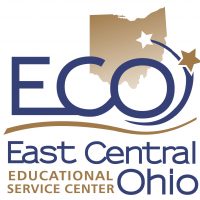About ECOESC World Languages
The East Central Ohio Educational Service Center (ECOESC) is well-versed in sharing academic courses through Interactive Video Distance Learning. Coordinator of Distance Education, Michele Carlisle, has been facilitating shared courses through IVDL technology since 1999 when Ohio school districts received the first large distance learning grants. During the ensuing years, Michele and the ECOESC have worked tirelessly to ensure that course delivery is seamless, reliable, effective, and effortless each day, allowing schools and students to focus on instruction, not the delivery model. Currently, the ECOESC employs a total of 16 world language instructors, each sharing live daily language instruction through distance learning.
World languages through East Central Ohio Educational Service Center focus on the targets of language instruction set forth by ACTFL standards; Communication, Culture, Connections, Comparisons, and Communities. We strive for teaching a second language through native, real-world practices and experiences; most class periods spend a target of 90% or more of the instructional time in the target language. Unlike world language classrooms in the past, where grammar and vocabulary drills dominated instruction, our world language program focuses on language learning for proficiency. In our language programs, students and teachers are engaged in the target language through authentic learning experiences, producing proficient speakers in the language.
All world languages through ECOESC are offered through live interactive video distance learning, and Zoom is most often utilized. In addition, to live, daily instruction, students have access to each class recording through a password-protected login as well.
Questions?
Michele Carlisle
Phone: (330) 308-9939 x 8220
Email: michele.carlisle@ecoesc.org
Using interactive video distance learning, Spanish level I will be offered on a per-period basis for the school year 2021-2022. The first year of Spanish concentrates on the learning of the present tense and various cultural aspects of the Hispanic World. The students begin to read, write, listen and speak in Spanish, using Ohio’s Model World Language framework as a guidestone, and proficiency in the target language as best instructional practice. Ohio’s World Language Model Curriculum identifies eight global themes that can serve as guidance for creating courses and units that are aligned from level 1 through AP level. Teachers can use the themes to determine the appropriate content, vocabulary or structures that will fit with the theme or topic that they choose.
Using interactive video distance learning, Spanish level II will be offered on a per-period basis for the school year 2021-2022. The second year of Spanish concentrates building upon previous Spanish instruction and developing deeper comprehension and communication in the target language. Ohio’s Model World Language framework is the guidestone, and proficiency in the target language as best instructional practice. Ohio’s World Language Model Curriculum identifies eight global themes that can serve as guidance for creating courses and units that are aligned from level 1 through AP level. Teachers can use the themes to determine the appropriate content, vocabulary or structures that will fit with the theme or topic that they choose.
English Learner (EL) students, as identified by the local district OELPA screener, may benefit from direct English instruction as part of the students’ daily academic schedule. Based on the student’s annual OELPA screener results, TESOL licensed instructor Taylor Gray provides instruction designed toward proficiency in the English Language. Guided by Ohio English Language Proficiency standards, students will move toward English proficiency through instruction. This English language instruction can be scheduled in 60 minute increments or less, depending upon the needs of the student and the availability of the instructor.
